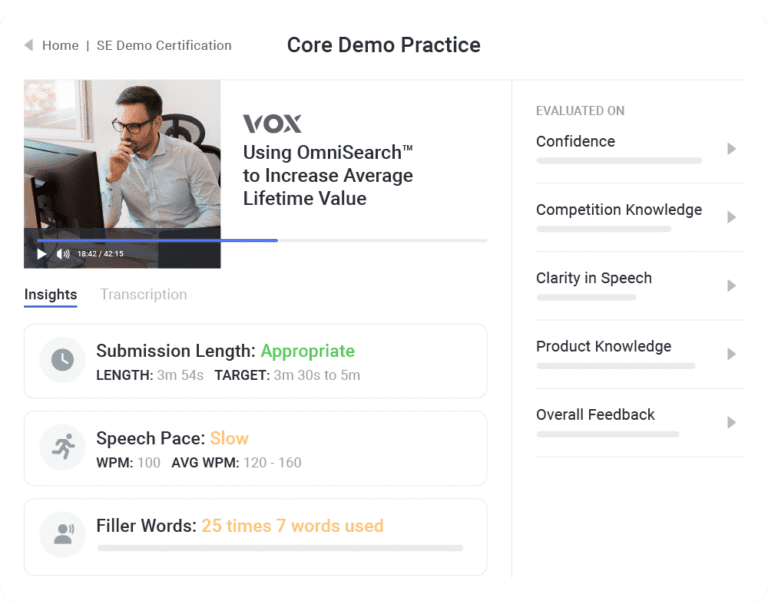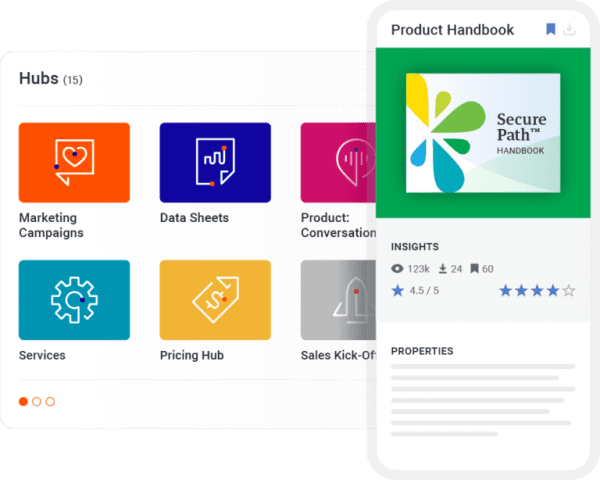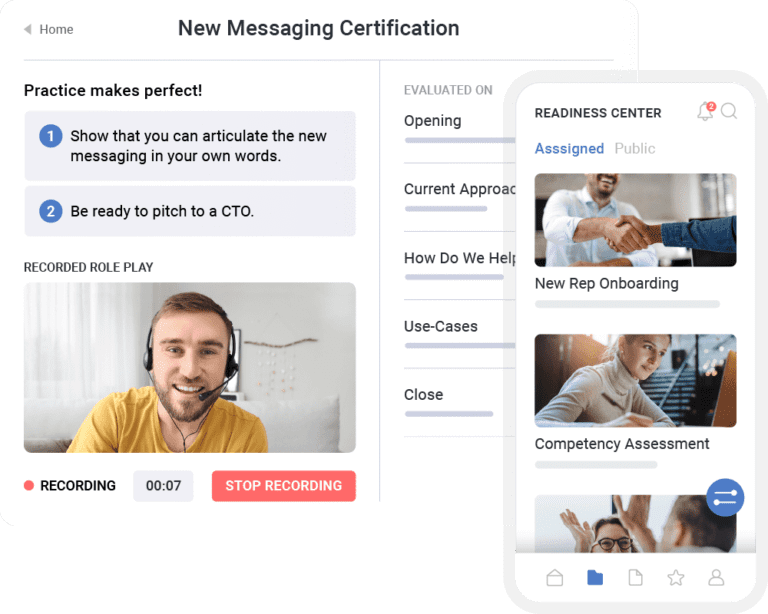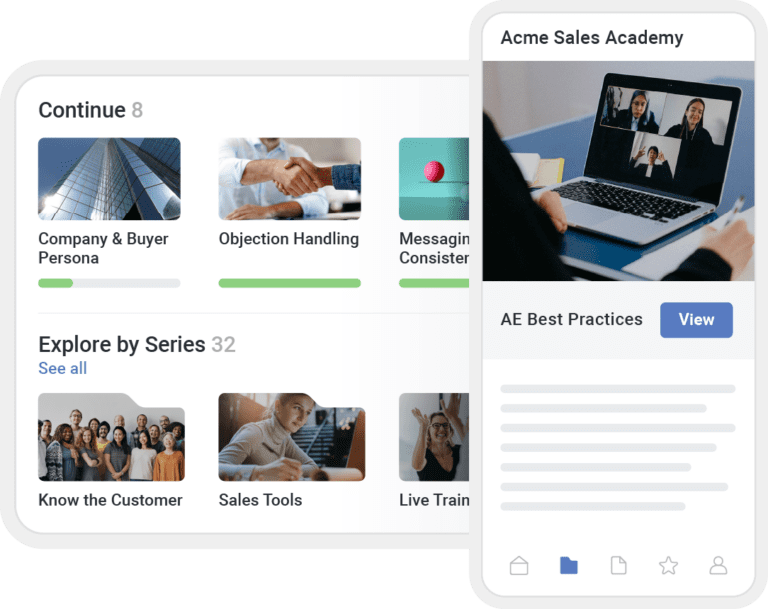Sales enablement leaders often struggle to demonstrate the impact of their efforts on business outcomes.
But closed deals don’t happen in isolation; effective sales enablement is an important piece in making sure sellers have everything they need to be productive.
The truth is that in 2023, only 42.8% of reps hit their quotas.
In 2023, only
Companies miss significant benefits without proper investment and structured programs geared toward revenue generation. Effective sales enablement drives revenue and equips sales reps with the tools to cultivate meaningful customer relationships, attract qualified leads, and close deals successfully.
Key takeaways
- A robust sales enablement structure centralizes all resources, knowledge, and content into a single source of truth. This means reps have just-in-time access to the information they need to engage buyers, saving time and enhancing productivity.
- Continuous training and skill development are essential to successful sales enablement initiatives. By providing regular training and opportunities for practice, sales enablement ensures that reps stay updated on industry trends, product updates, and best practices.
- Sales enablement empowers managers to create a coaching culture by providing them with data-driven insights and tools to facilitate individual reps and teams coaching sessions. Managers are better able to identify areas for improvement.
Sales enablement supports overall seller productivity
We define sales enablement as the process of providing the sales organization with the information, content, and tools that help sellers sell more effectively. The foundation of sales enablement is to provide sellers with what they need to successfully engage the buyer throughout the buying process.
Practically speaking, sales enablement teams identify skill gaps through performance metrics, assessments and feedback. They then tailor training and development programs based on these skill gaps.
Example: Skill and knowledge gaps
Let’s look at a hypothetical, but realistic, problem. ABC company is in the process of assessing its sales readiness. During the process, the sales team noticed that there were gaps in the skills their sales reps have versus the skills they need to sell effectively. Sales leaders at ABC correlate this to a recent decline in deals closed, which has also resulted in not meeting revenue goals.
ABC can employ sales enablement efforts to fix this misalignment. They can identify which parts of the sales workflow are most difficult for each sales rep, like converting leads into opportunities or upselling, for example. Then they can leverage that data to train and enable each rep based on their individual skills gap.

Sales enablement provides an accessible knowledge base
A strong sales enablement structure gives your salespeople access to a knowledge base, one that’s designated as a single source of truth. A designated knowledge base saves them from spending a lot of time looking for information or answers while they’re working with a customer. It promotes just-in-time access to the resources they need.
Sales enablement makes knowledge more accessible by gathering all resources, knowledge, and sales content into one spot. Here are some examples of what to include in your knowledge base:
- Sample scripts or talk tracks
- Information about customer personas and pain points
- Links to training modules
- Customer-facing content
No matter what they need to access, they can get it all within this single source of truth.
Example: One source of truth
Say your sales teams have knowledge spread out across multiple tools (like a CRM, a company wiki, and multiple drives). With too many places to look, it’s hard for your reps to find what they need in a timely manner during a customer interaction.
Sales enablement managers should come together to decide which source will be designated as the single source of truth. If you already have a drive or knowledge base tool in place that every necessary person has access to, start there. Even a simple tool like Google Drive can work for organizing all your relevant content and knowledge in one spot.


Sales enablement promotes ongoing sales training
Sales enablement helps your reps hone their skills and develop industry knowledge through ongoing sales training and practice. Technology evolves all the time – products are updated; new tools are adopted; objectives and KPIs are changed. Ongoing training prepares your reps for these inevitable changes. Training gives them insights and advice they can use during customer interactions like more compelling messaging examples or how to resolve common conflicts or objections effectively.
Training is a big part of any successful sales enablement initiative. Sales enablement promotes an environment where your salespeople are continually building their skills and knowledge. Then they put their skills to the test in common real-life scenarios through role-playing or other simulations.
Example: Stopping skill erosion
Skill erosion refers to a decline in a certain skill set, usually because that skill isn’t used often enough. Ongoing training helps your reps with skill reinforcement, so they can integrate those skills into their tasks, leading to more valuable and successful customer conversations.
To avoid skill erosion, make ongoing learning part of your sales team’s everyday routine. One tool that can help is Mindtickle. In the Mindtickle platform, you can use AI-powered skill reinforcements, role plays, and more to protect your reps from skill erosion.


Sales enablement helps your managers create a coaching culture
For your sales teams to succeed, they need a supportive and knowledgeable coach. Sales enablement can help you create an effective coaching culture using data-driven insights, provide teachable moments, and easily facilitate coaching sessions for teams and individual reps.
A strong sales enablement strategy includes specific skill resources and behavioral training that help your managers coach your sales reps. This includes data they can use to identify areas of improvement in the workflow and technology to help make those improvements.
Take conversation intelligence technology, for example. This technology lets you tap into sales calls to understand your sales reps’ behaviors and skill sets.


Example: First-time manager training
If you have a lot of first-time managers, it’s especially important to provide training on topics relevant to leading a team. These topics include effective communication, conflict resolution, how to handle performance reviews, and how to provide support to sales reps.
For instance, all sales managers should be well versed in how to handle objections since this is a common obstacle for every sales rep. Moreover, your managers should have resources and support to make them feel confident in their coaching abilities, enabling them to give their sales reps effective solutions to any problem.
Sales enablement removes silos between sales and marketing
When marketing and sales are siloed, each one is more focused on their individual goals rather than the overall company goal. This can affect overall productivity and collaboration, making it harder to get tasks done related to content, branding, and general marketing.
When sales and marketing can work together, companies can attract and close more leads. Think of marketing as the bait that attracts the leads and sales as the line that reels them in.
By implementing standards and processes on how these two teams should work together, you can break down the silos and increase collaboration.
Example: Content creation
Sales reps don’t have the time or often the skills to create their own content – they need marketing. Your marketing team is experienced in creating content that resonates with your target audience and attracts qualified leads.
Let’s say you need a specific piece of relevant content from your marketing team. With no standards or processes for content creation, your marketing team doesn’t know that they’re supposed to create the content. Your salespeople may feel obligated to create it themselves or skip it all together. The result is often less effective sales tactics and resources.
Alternatively, with a process in place, your sales reps will know when and how to engage marketing, and marketing folks will understand the types of situations they may be employed to help.
Sales enablement can expedite onboarding for new salespeople
Sales enablement in your onboarding programs can get your reps effectively prepared to sell. Reps at winning orgs onboard their reps faster and get their sellers out into the field — and productive — much faster.
Example: Personalized training to decrease ramp time
Each one of your salespeople is different. They all have varying skill levels and skill sets, and they come from different professional backgrounds. The idea behind sales enablement is to be able to personalize training based on the experience each rep already has and the skills they still need.
A sales enablement platform like Mindtickle automates your onboarding process from start to finish with personalized training based on each rep’s background and experience. It helps them build on the specific skills and knowledge they need to be successful without sitting through training that might be irrelevant to them.
Sales enablement can reduce sales rep turnover
Sales enablement can decrease rep turnover by keeping your salespeople engaged. Engaged employees feel more committed to the work they do and to the company they work for. On the other hand, disengaged employees often feel more burned out and end up costing you much more than engaged employees.
Sales enablement can help build a team of engaged sales reps by helping them develop their skills and navigate challenges as they arise and generally cultivating a positive seller environment – all factors that make them less likely to leave.
Example: Keep your reps engaged
Engaged salespeople are more optimistic, selfless, and team-oriented and show a passion for learning. One way to keep your sales reps engaged is by showing an interest in their career goals and helping them reach those goals.
For instance, if you have a sales rep who wants to become a sales manager, you can suggest resources, training, and content they can access to build their knowledge and skills.


Sales enablement keeps your potential customers informed
Sales enablement is also about properly communicating and educating your customers via helpful content and your well-prepared sales reps. Informed customers are more likely to make a purchase from you if your product aligns with their needs.
With effective sales enablement, you can proactively answer customers’ questions and acknowledge the challenges they experience every day.
Example: Create memorable experiences to keep customers in the sales funnel
To keep your customers engaged, create memorable experiences that keep them in your sales funnel. Personalize your communications to them, craft impactful messaging, and provide high-value content that meets them where they’re at in the funnel.
For example, if you’re writing content for people who are somewhere in the middle of your sales funnel, write blogs or emails to offer helpful advice and tips like “How to Use [Our Software] to Do [This] Task” or “X Reasons You Need [Our Software] to Boost Sales.”
This type of content addresses pain points and offers helpful solutions, which can help convince them that your product is the right one for them.
Refine your sales enablement by measuring sales effectiveness over time
We know what you’re probably thinking: “This is a lot.”
It can be.
But one easy way to incorporate sales enablement into your company is to use a software tool specifically designed for that purpose. A sales enablement tool can capture, analyze, and score all buyer interactions, so you can measure how effective your sales tactics are.
Rather than trying to change the systems of multiple departments and processes, you’ll have one platform from which you can roll out the changes with minimal disruption.
Mindtickle’s suite of tools and processes can help your salespeople increase their knowledge, boost their performance, and feel confident going into every customer conversation.
Schedule a demo with us or learn more about how sales professionals use Mindtickle for effective sales enablement.
Sales Enablement in Mindtickle
Schedule a demo to learn more about how sales enablement pros at winning orgs use Mindtickle for effective sales enablement.
Get a DemoThis post was originally published in August 2022, updated in July 2023, and again in March 2024.







